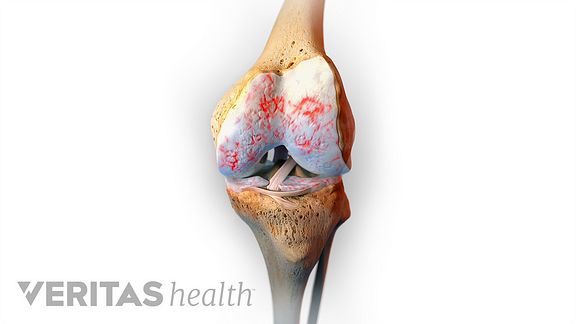Knee Pain and Arthritis
Knee pain is a very common reason for a visit to a primary care doctor, and that is not surprising: the knee is the largest joint in the body and supports almost the entire weight of the body, both when upright and when bending. If just one element of the complicated knee joint is damaged, the knee can become painful.
See Possible Causes of Severe Knee Pain
Knee pain and discomfort can be experienced many different ways: a dull ache, a sharp, stabbing pain, possibly accompanied by stiffness, warmth and swelling of the knee. Some people also experience weakness or locking of the knee joint, which can be a strange and discomfiting sensation and inhibit one’s ability to function.
See How to Care for a Swollen Knee

Because the knee is such a complex and essential joint, it is important to pay attention to any type of knee pain and obtain an accurate diagnosis for the cause of the pain. Many people mistakenly consider knee pain just a normal part of aging, but a healthcare professional can often identify the cause and prevent progression of the symptoms.
See Arthritis Treatment Specialists
Knee Joint Pain from Arthritis
Arthritic knee pain can present itself in many different ways. The specific symptoms will depend on a number of factors, including the degree and nature of joint degeneration, the patient’s condition (such as weight and physical fitness) and the patient’s individual perception of pain.
That being said, there are certain signs and symptoms of arthritic knee pain that are typical among most patients. For most, the knee pain associated with osteoarthritis is usually characterized by some combination of the following symptoms:
Knee pain that comes and goes
In most but not all cases, the symptoms of knee osteoarthritis come and go, becoming gradually worse and more frequent over a number of years. There may be a persistent, dull ache, accompanied by flare-ups of more intense pain after certain activities that strain the knee joint (such as walking up stairs).
With severe osteoarthritis of the knee, the pain can become continuous, interrupting sleep and making any form of weight-bearing activity severely painful.
Two distinct types of arthritic knee pain
In a recent study that explored the nature of pain through extensive interviews with 20 patients, 80% profiled two distinct types of knee pain: mechanical pain and inflammatory pain1:
-
-
- Mechanical pain. This type of pain was described in many different ways, such as sharp or aching. It resulted from weight-bearing activities and knee joint movements, such as climbing stairs or squatting down. This type of pain intensified with increased knee joint strain and went away after a brief period of rest. It was also worse after a prolonged period of inactivity, such as getting up after sitting for a long time, and would go away after a few minutes of gentle movement of the joint.
- Inflammatory pain. This type of arthritic pain was often described in the interviews as burning, and often accompanied by swelling and a sensation of warmth. It was less predictable, sometimes occurring as flare-ups of intense pain in addition to the dull, aching form of mechanical pain, brought on by changes in the weather or by activity.
-
Certain things make the knee pain worse
-
-
- Prolonged inactivity. The pain and stiffness is usually worse when getting out of bed in the morning or after sitting for a long period in the car.
- Bending. Using the joint while bearing weight, such as bending down, getting in or out of the car, or walking up stairs, typically makes the pain worse.
- Overuse. Pain may intensify after certain sports or activities, such as walking a long distance or any activity involving repetitive bending or pressure on the knees (e.g. kneeling while gardening).
-
Certain things make the knee pain better
-
-
- Rest. After a painful flare, the pain usually subsides after resting for a relatively short period.
- Ice and/or heat. Applying ice or a cold compress after activity-related pain usually provides a quick reduction in pain as it reduces inflammation. Applying a warm compress or heating pad, or sitting in a hot whirlpool bath, usually provides a soothing form of pain relief.
-
See When and Why to Apply Heat to an Arthritic Joint and When and Why to Apply Cold to an Arthritic Joint
-
-
- Gentle/moderate activity. When the knee joint is used, it secretes synovial fluid between the cartilage in the joint. This fluid is viscous, with a consistency described as similar to an egg yolk. Its primary role is to reduce friction in the joint, which in turn helps with flexibility and reducing pain.
- Weight loss. Losing weight, as appropriate, helps reduce strain on the knee, thereby reducing pain and slowing the joint degeneration.
-
See How Effective is Weight Loss for Treating Knee Arthritis Pain?
Referrence
- 1.Keith K.W. Chan, Loretta W.Y. Chan, “A qualitative study on patients with knee osteoarthritis to evaluate the influence of different pain pattersn on patients’ quality of live and to find out patients’ interpretation and coping strategies for the disease,” Rheumatology Reports, Vol.3 No.1 (2011).




